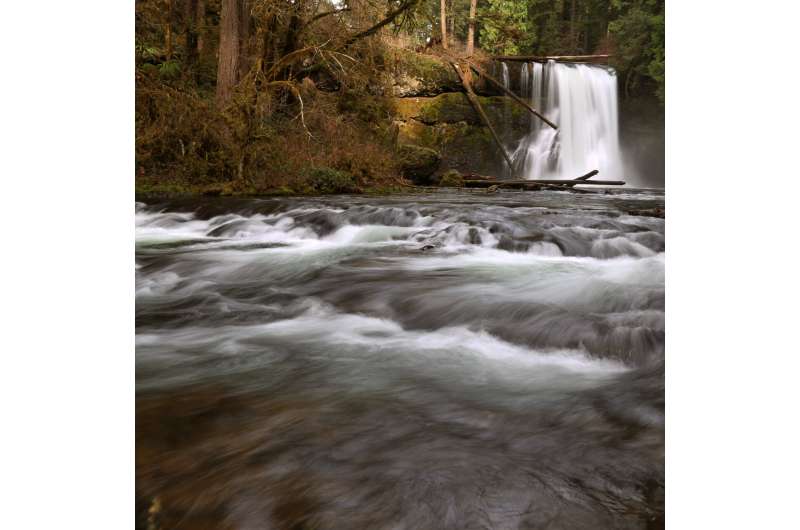This article has been reviewed according to Science X's editorial process and policies. Editors have highlighted the following attributes while ensuring the content's credibility:
fact-checked
trusted source
proofread
Is Instagram making the great outdoors more crowded? Not as much as you might suspect

Except for modest visitor increases at a small percentage of iconic places, Instagram content is not resulting in more tourist traffic on public lands, according to a study by researchers at Oregon State University.
The findings, published in Land Economics, counter a common news media refrain that geotagged posts on social media are "ruining the great outdoors," said Steve Dundas and Ashley Lowe Mackenzie of OSU's College of Agricultural Sciences.
The research also adds to the ongoing quest to understand the role social media plays in society, as well as to policy discussions around social media regulation, the scientists note.
"This has a number of interesting policy implications for public land managers," said Dundas, associate professor of applied economics. "Access to information on the online activity for publicly managed areas could help administrators better understand visitor trends and behaviors to help steward these locations for current and future generations."
Dundas and Lowe Mackenzie paired 18 years of visitation data to Oregon state parks with data on park-specific geotagged Instagram posts and their engagement, or the volume of likes and comments that those posts generated.
Geotagging means attaching geographic information to images, video or other content captured by smartphones or other GPS-enabled electronic devices. The information includes latitude and longitude coordinates, altitude and other data, making a potentially hard-to-find spot much easier for new visitors to locate.
The researchers found that the cumulative effect of "viral" content was associated with monthly visitor increases of about 4% at four of Oregon's 50 state parks: Silver Falls in the Cascade foothills, Smith Rock in central Oregon, and Oswald West and Ecola on the coast.
Beyond that quartet of locations, the researchers saw no evidence that Instagram was having an effect on visitor traffic.
"During the 2010s, public lands across the United States experienced large visitation increases, which led to overcrowding of some parks," said lead author Lowe Mackenzie, who completed her doctorate in applied economics this spring. "Some journalists accused social media, and in particular Instagram, of causing this increased visitation. The reason Instagram received the blame was that content was often geotagged. Journalists created headlines about the public loving our parks to death with Instagram clearly labeled as the responsible party."
But that rather simplistic storyline is largely inaccurate, Dundas said.
"Our paper finds that content on Instagram is not associated with increased visitation in most parks," he said. "To the extent Instagram content and engagement do impact visitation to public lands, they don't do so uniformly. Our results suggest locations with picturesque or iconic landscapes may be susceptible to impacts from social media because the content generated at those sites may become popular online and has the opportunity to spread to many new people."
That is to say, it's not just sharing photos with specific geographic info that makes a difference in how many visitors a spot receives—the photos have to receive high engagement.
"We found viral content uploaded and geotagged to Smith Rock, Silver Falls, Oswald West and Ecola state parks had a prolonged effect on increasing visitation at these parks—not just an effect right after the contest was posted," Lowe Mackenzie said. "Our research concentrated on the impacts of Instagram; however, other online sites that use engagement as a way to promote content could have had impacts as well—Twitter, Tiktok, AllTrails, YouTube, etc."
Public land managers have a responsibility to protect habitats and ecosystem health while also facilitating the visitation and enjoyment of the lands they're responsible for, Dundas notes. But management agencies are often underfunded and understaffed, meaning that big increases in visitation can lead to the degradation of both sensitive ecosystems and the visitor experience.
"Our results provide some insight into how land managers may be able to use social media to understand visitation trends and to be better prepared," he said. "Social media represents a relatively new way for people to gather information and learn about new places. This research represents a first step in trying to understand how this online information translates to offline behavior changes."
More information: Ashley Lowe Mackenzie et al, The Instagram Effect: Is Social Media Influencing Visitation to Public Land?, Land Economics (2023). DOI: 10.3368/le.100.2.122920-0192R1
Provided by Oregon State University




















